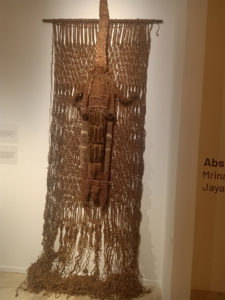Bringing together the works of seven different women artists, the Kiran Nadar Museum of art is showcasing pieces that strike up a conversation amongst diverse practices
Bringing together 160 artworks belonging from different stages and artistic careers of seven women artists, Kiran Nadar Museum of art has a triad of exhibitions – Scripting Time, Memory, Ecology curated by Roobina Karode.
The ongoing exhibition “Abstracting Nature: Mrinalini Mukherjee and Jayashree Chakravarty” is part of this triad. The show revisits and engages with a gamut of languages of abstraction.
The artworks from the KNMA collection, loans from artists, artist’s estates, galleries and private collectors are exhibited in a pattern that interconnects and strikes a conversational relation amongst the diverse practices of the artists.
“The exhibitions showcase works of seven women artists, whose personal experiences and generational differences spanning numerous decades mark the key moments in the long and troubled duree of South Asian history. Providing a spectrum of artistic languages varying from the abstract and allusive to the quasi-representational. These works gracefully move between the spiritual and political, the frugal and exuberant”, says Karode.
The curation of this series puts into perspective an alternative narrative which is removed from a parochial art historical mapping of abstraction as a forte restricted to practices of male artists.
In the show Abstracting Nature with Mrinalini Mukherjee and Jayashree Chakravarty there is a complementary approach where they amalgamate the myriad objects, images and ideas extracted from nature into their own oeuvre, both as an abstract and in a cryptic visual language.
Viewers get to engage, for the first time perhaps with drawings, etchings and watercolour produced by Mrinalini Mukherjee who is well known for her hemp sculptures. Seeking solace in the serenity of nature deeply resonates with both the artists’ practice and philosophy.

The suite of monochromatic works consisting of etchings and watercolour works from the museum collection dates back to Mukherjee’s early decades of her art practice. Renditions of disparate landscapes in motion through swift strokes in Storm (1984), View (1983), Moonlit Walk (1982), Path (1983) and bronze sculpture series Palm Scape from the museum collection are on display among others.
For several decades now, Chakravarty’s preoccupations and concerns in her practice have largely addressed the shrinking of natural habitat and water bodies in ever-expanding Indian cities.
Based in a rapidly urbanising suburb in Kolkata, she witnessed the rich marshlands of Salt Lake, transform into “Salt Lake City”, now a congested residential settlement. Having lived there for the last 35 years, Chakravarty was also witness to the life that once thrived there – giant fish, aquatic plants, waterfowl, snails and creepy crawlies, all her companions that now inhabit her paintings as ‘memory-images’.
Chakravarty’s suggestive forms nearing abstraction in contrast to Mukherjee’s powerful rendition of fleeting glimpses as one remembers landscapes and nature, strike unique yet connected understanding of abstractions from nature.
The exhibition is on display at KNMA’s social media handles
(Cover: Jayashree Chakravarty mixed media on paper)





